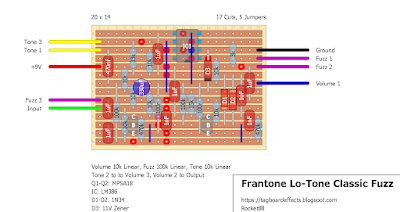In October 2003, Dan Coggins (formerly of Lovetone) released his first commercial pedal under the Dinosaural brand, called the Tube Bender. His design goal was to make something that was sort of a tonal hybrid of the Tone Bender and Tube Screamer, hence the name. And honestly, having listened to it, I’m not sure there’s a better way to describe it. He only made around 140 of them between 2003 and 2007, but many of them were snatched up by musicians and producers in the UK. So while they’re exceedingly rare, you’ve most likely heard it.
I added a mod from the AION Wyvern Silicon Drive of a second position to the Tone Shift switch that’s in-between the flat and scoop modes. I've included the hfe readings from an original pedal as per Aion's trace, so you can try different transistors with similar gains.
It's so rare I couldn't find a demo of it, but I think you get the gist of what it should sound like.











